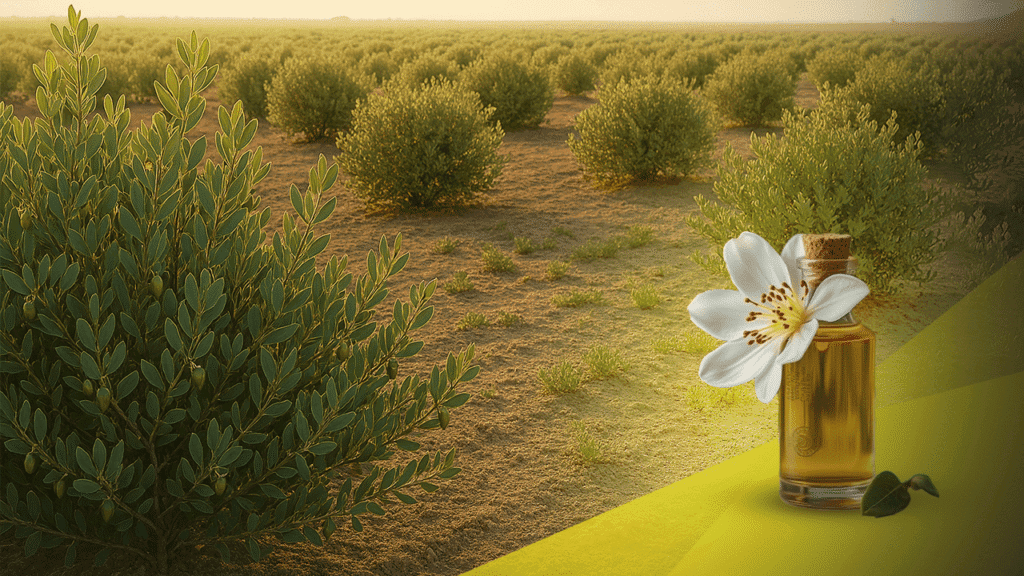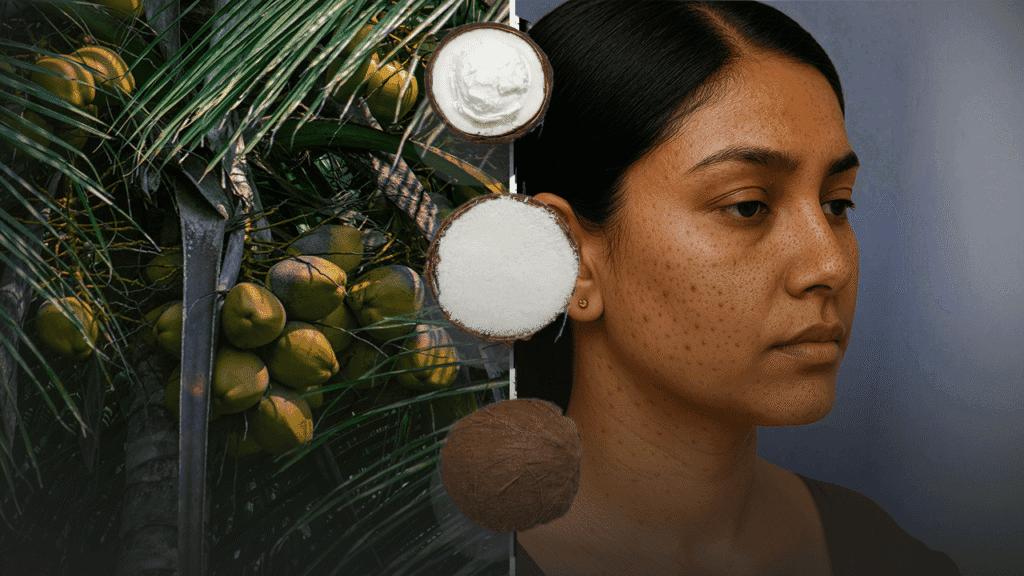Advertisement

- Updated on May 14, 2025
- IST 8:06 am
Your coconut oil habit might be clogging pores—dermatologists spill the truth!
Imagine this: you’re standing in front of your bathroom mirror, scrutinizing your skin. You notice a few pesky pimples that weren’t there yesterday. You think back to your skincare routine—cleansing, toning, moisturizing with your trusty coconut oil. Wait a minute, could your beloved coconut oil be the culprit? For generations, coconut oil has been a staple in Indian households, from cooking to hair care, revered as a miracle elixir. But when it comes to face care, the story isn’t so straightforward. Some dermatologists are sounding the alarm, warning that this kitchen-shelf hero might be clogging your pores and causing more harm than good.
In this deep dive, we’ll unravel the coconut oil controversy, focusing on its impact on Indian skin types. We’ll explore the science behind comedogenicity, hear from experts, and discover lighter alternatives like jojoba oil that might just save your skin. Tailored for Indians aged 15 to 45, this blog will blend research, storytelling, and practical tips to help you make informed skincare choices. So, grab a cup of chai, settle in, and let’s get to the bottom of this oily debate!

Understanding Comedogenicity: The Pore-Clogging Culprit
Before we dive into coconut oil’s role, let’s break down what comedogenicity means. In simple terms, comedogenicity is how likely a substance is to clog your pores, leading to those dreaded blackheads and whiteheads—aka comedones. Think of your pores as tiny gateways; when they get blocked, trouble brews beneath the surface.
The comedogenic scale ranges from 0 to 5:
- 0: Non-comedogenic (won’t clog pores)
- 5: Highly comedogenic (very likely to clog pores)
This scale is a skincare compass, guiding us toward ingredients that suit our skin. So, where does coconut oil fit? It’s rated around 4—yep, pretty high up there. That means it’s got a strong chance of blocking pores, especially for acne-prone folks. But isn’t coconut oil natural and supposed to be good for us? Hold that thought—we’re about to find out why it’s not always a skin savior.

Coconut Oil and Indian Skin Types: A Love-Hate Story
In India, coconut oil isn’t just a product—it’s a cultural icon. From the lush groves of Kerala to the bustling streets of Mumbai, it’s everywhere. For centuries, Ayurveda has praised its moisturizing and healing powers, making it a go-to for hair, body, and even face care. But here’s the catch: Indian skin types are as diverse as our landscapes—oily, dry, combination, sensitive—and coconut oil doesn’t play nice with everyone.
Take Priya, a 25-year-old from Delhi. She swore by coconut oil for her dry skin, slathering it on religiously. At first, her skin felt soft and hydrated, but weeks later, tiny bumps and breakouts appeared. Confused, she visited a dermatologist who pointed the finger at coconut oil’s heavy texture. Priya’s not alone—many Indians, especially in our hot, humid climate, find that coconut oil’s richness turns from a blessing to a blemish-causing burden.
Why? India’s weather often amps up oil production, and for those with oily or combination skin (super common here), coconut oil’s comedogenic rating of 4 can spell trouble. It’s like pouring ghee on a sizzling pan—things get messy fast. But does that mean coconut oil is a skincare villain for everyone? Let’s hear what the experts say.

Dermatologists’ Perspectives: The Science Speaks
To dig deeper, I spoke with Dr. Anjali Shah, a Mumbai-based dermatologist with over a decade of experience. “Coconut oil is rich in medium-chain fatty acids, like lauric acid,” she explains. “While that’s great for antimicrobial effects, it’s too occlusive for many skin types. It sits on the surface, trapping dirt and bacteria, which leads to clogged pores and acne.”
Dr. Rajesh Verma from Bangalore echoes this. “For acne-prone skin, coconut oil is a risky bet,” he says. “Its benefits—like fighting bacteria—don’t outweigh the pore-clogging downside for most people.” But it’s not all bad news. Dr. Shah notes, “For dry skin conditions like eczema, coconut oil’s anti-inflammatory properties can help. It’s just not a one-size-fits-all face moisturizer.”
The science backs them up. Coconut oil’s saturated fats, especially lauric acid, make it thick and heavy. Studies show it forms a barrier on the skin, locking in moisture (great for dry skin) but also trapping sebum and dead cells (a disaster for oily skin). Plus, some research hints it might disrupt the skin’s natural barrier over time, causing sensitivity. So, while it’s a champ in your hair mask, your face might not thank you.
The Flip Side: When Coconut Oil Shines
Let’s not toss coconut oil out just yet. For some, it’s a holy grail. If you’ve got dry or mature skin, that occlusive layer can be a hydration hero, especially in India’s harsh summers or dry winters. My cousin Swati, 38, swears by it for her parched cheeks, saying, “It’s like a shield against Delhi’s dust!” Small studies even suggest its antimicrobial properties can tackle mild infections or soothe irritation.
But here’s the kicker: skin type is king. What works for Swati might wreak havoc on Priya. And with India’s penchant for oily skin—thanks to genetics and climate—coconut oil often tips the scales toward breakouts. So, if it’s not the universal fix, what’s the alternative?
Lighter Alternatives: Jojoba Oil and Beyond
Enter jojoba oil, the lightweight contender. Extracted from the jojoba plant’s seeds, it’s a skincare MVP with a comedogenic rating of 2—far friendlier than coconut oil’s 4. What’s special? It mimics your skin’s natural sebum, balancing oil production without clogging pores. “Jojoba oil is a game-changer,” Dr. Shah says. “It’s packed with vitamins E and B, perfect for hydrating Indian skin without the grease.”
Then there’s argan oil, rated 0 on the comedogenic scale. Hailing from Morocco, it’s loaded with antioxidants and fatty acids, hydrating without heaviness. For an Ayurvedic twist, try sesame oil (til oil), used for centuries in India for its detoxifying perks, or almond oil, a nourishing lightweight option.
Let’s compare:
- Coconut Oil: Comedogenic rating 4, heavy, best for dry skin
- Jojoba Oil: Comedogenic rating 2, mimics sebum, suits most skin types
- Argan Oil: Comedogenic rating 0, lightweight, antioxidant-rich
- Sesame Oil: Low comedogenic risk, Ayurvedic detoxifier
These alternatives offer hydration without the breakout baggage—ideal for India’s diverse skin needs.

Practical Skincare Tips: Finding Your Perfect Match
Ready to rethink your routine? Here’s how to choose and use oils wisely:
- Know Your Skin: Oily? Go for argan or jojoba. Dry? Coconut might still work. Combination? Jojoba’s your bestie.
- Patch Test: Dab a little on your jawline for 24 hours to spot reactions.
- Less is More: A few drops on damp skin lock in moisture without overload.
- Layer Smart: Apply oil after serums, before heavy creams.
- Cleanse Well: Double cleanse at night to remove oil and grime.
Try this simple routine with jojoba oil:
- Morning: Cleanse, tone, add jojoba oil, top with sunscreen.
- Night: Double cleanse, apply a serum (like niacinamide), seal with jojoba.
It’s low-effort, high-impact—and pore-friendly!

Conclusion: Your Skin, Your Rules
The coconut oil controversy isn’t black and white. It’s a skincare staple with benefits—hydration, antimicrobial magic—but its high comedogenic rating makes it a gamble for many Indian skin types. Dermatologists aren’t wrong to raise red flags, especially for oily or acne-prone folks. Yet, for dry skin warriors, it might still hold a place.
The takeaway? Listen to your skin. If coconut oil’s leaving you spotty, swap it for jojoba, argan, or an Ayurvedic gem like sesame. Skincare’s personal—what’s a miracle for one might be a mess for another. So, experiment, tweak, and find your glow. Your face deserves it!
You May Like This
Advertisement

You May Like This








Advertisement

Advertisement

Advertisement


